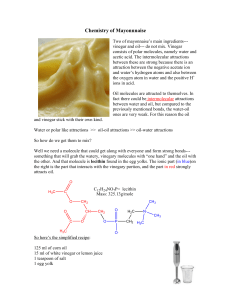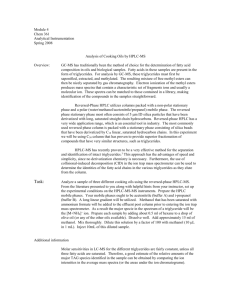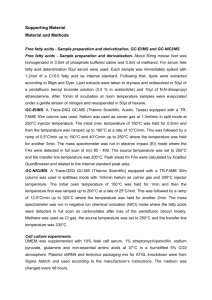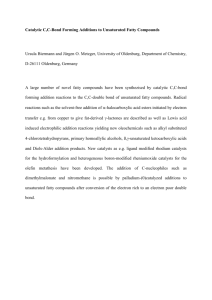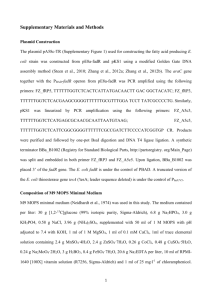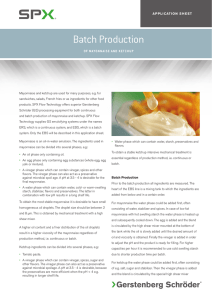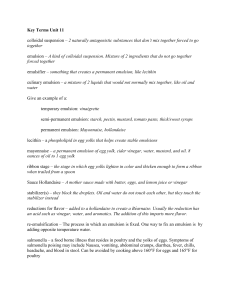Can you get oil and water to mix?
advertisement
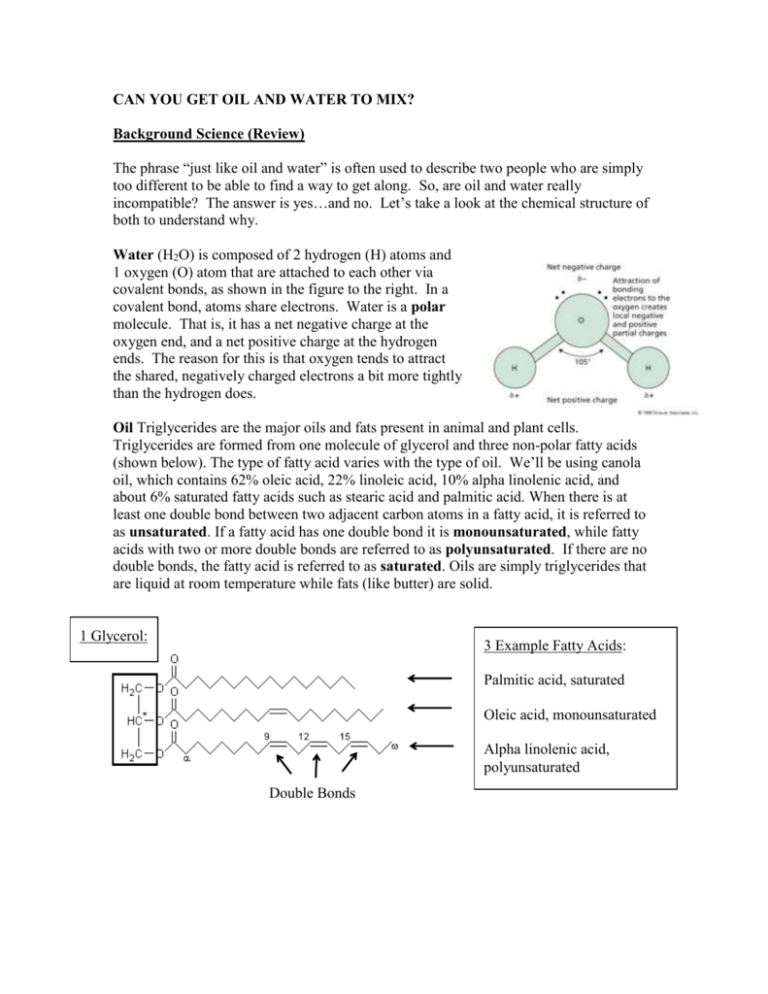
CAN YOU GET OIL AND WATER TO MIX? Background Science (Review) The phrase “just like oil and water” is often used to describe two people who are simply too different to be able to find a way to get along. So, are oil and water really incompatible? The answer is yes…and no. Let’s take a look at the chemical structure of both to understand why. Water (H2O) is composed of 2 hydrogen (H) atoms and 1 oxygen (O) atom that are attached to each other via covalent bonds, as shown in the figure to the right. In a covalent bond, atoms share electrons. Water is a polar molecule. That is, it has a net negative charge at the oxygen end, and a net positive charge at the hydrogen ends. The reason for this is that oxygen tends to attract the shared, negatively charged electrons a bit more tightly than the hydrogen does. Oil Triglycerides are the major oils and fats present in animal and plant cells. Triglycerides are formed from one molecule of glycerol and three non-polar fatty acids (shown below). The type of fatty acid varies with the type of oil. We’ll be using canola oil, which contains 62% oleic acid, 22% linoleic acid, 10% alpha linolenic acid, and about 6% saturated fatty acids such as stearic acid and palmitic acid. When there is at least one double bond between two adjacent carbon atoms in a fatty acid, it is referred to as unsaturated. If a fatty acid has one double bond it is monounsaturated, while fatty acids with two or more double bonds are referred to as polyunsaturated. If there are no double bonds, the fatty acid is referred to as saturated. Oils are simply triglycerides that are liquid at room temperature while fats (like butter) are solid. 1 Glycerol: 3 Example Fatty Acids: Palmitic acid, saturated Oleic acid, monounsaturated Alpha linolenic acid, polyunsaturated Double Bonds What Happens When You Mix Oil and Water? In the first part of this activity, you will have your students mix together oil and water and make observations. The food coloring is added to the water ahead of time to make the observations clearer. Your students should observe many things, including: As the oil and water are shaken, the oil disperses into small bubbles suspended in the water, forming an unstable oil/water emulsion. As soon as the shaking stops, the emulsion breaks down and the oil bubbles all fuse together (aggregate) to minimize surface contact with the water. Aggregation completes as the oil bubbles finally fuse to form a layer on top of the water (the oil is less dense than water). The oil never dissolves in the water, no matter how long you shake it Emulsifiers Emulsions are mixtures of two liquids that normally can’t be combined, and that separate from one another very quickly (like the oil and water above). The incompatibility of oil and water lies in their structural differences. As we learned previously, water is polar, while the long fatty acid chains of oil are not. Thus, they repel each other. In fact, oils and fats are referred to as being ‘hydrophobic’ (water fearing) for this very reason. An emulsifier is a substance that makes a liaison between the two liquids and stabilizes the emulsion. Common emulsifiers in foods include the lecithin in egg yolks, mustard, honey and many food additives. Mayonnaise is an example of a stable emulsion. Mayonnaise is made by combining lemon juice or vinegar with egg yolks, salt and oil. Lecithin in the egg yolks is a good emulsifier because it has both a polar (hydrophilic) group and a non-polar (hydrophobic) group. The hydrophobic group sticks into the oil, while the hydrophilic group sticks out into the water, effectively binding the oil to the surrounding water, while preventing the dispersed oil droplets from aggregating because of they are now surrounded by the polar groups. The result is a nice, thick, stable emulsion consisting of a lot of oil droplets surrounded by a tiny layer of watery lemon juice or vinegar. A brief divergence into the history of mayonnaise: The original mayonnaise (“Mahonnaise”) was invented created by the Duc de Richelieu’s chef in 1756 in a feast to commemorate the Duc’s victory over the British at Port Mahon. The chef ran out of cream, and in desperation added oil to his eggs to make a sauce, instead. The rest is history. The Experiment: Can you get oil and water to mix? Overview: During the next two class sessions you will use the information from your textbooks and the Mayo Clinic video to try to devise the perfect recipe for mayonnaise. During the first class period (today), you will use clear scientific reasoning to design and justify an initial recipe, which you will then make. During the next class period you will revise your recipe using your own observations, the observations of your classmates, and any other sources you can find. Will you succeed in making a better mayo the second time around? Ingredients 1 egg yolk 1/2 teaspoon fine salt 1/2 teaspoon dry mustard 2 pinches sugar 2 teaspoons fresh squeezed lemon juice 1 tablespoon white wine vinegar 1 cup oil, safflower or corn Italicized ingredients are included for flavor only. Making Mayo – First Try: On the next page, write down a step-by-step recipe that scientifically justifies each step, and that includes space to make observations as you perform each step. These observations will probably be critical to revising your recipe during the next class period. Make sure you detail and scientifically justify 1) the order in which you add ingredients, 2) how much of each ingredient you will add (will you add everything at once, or just a little at a time?), 3) and any other important considerations (time, mixing speed, temperature, etc.) I have included the first step for you on the next page, by way of example. Add more steps as necessary. Team Application Problems: Can you Get Oil and Water to Mix? Names: Step One: Warm the refrigerated egg and all other ingredients to room temperature. Step One Scientific Justification: Warming will speed up the rate at which the lecithin from the egg yolk will be transferred to the oil droplets during mixing (this info can be found on page 634 of your textbook). Step One Observations: None of the ingredients appeared to change as they were warmed to room temperature. Step Two: Step Two Scientific Justification Step Two Observations: Add Steps as Needed…..

